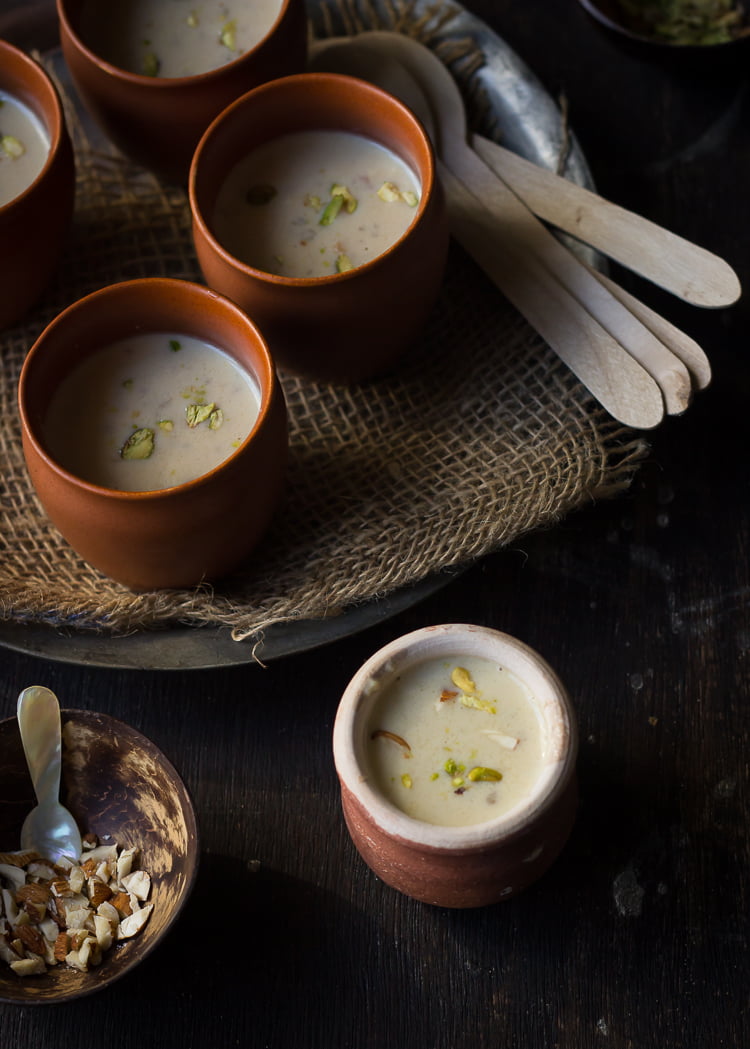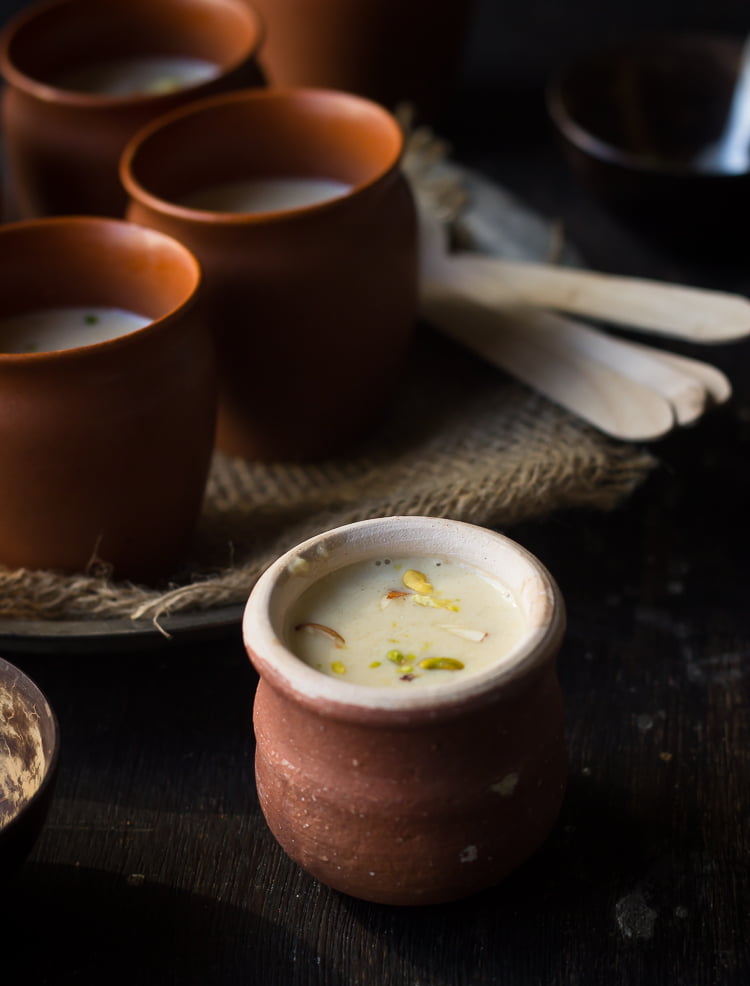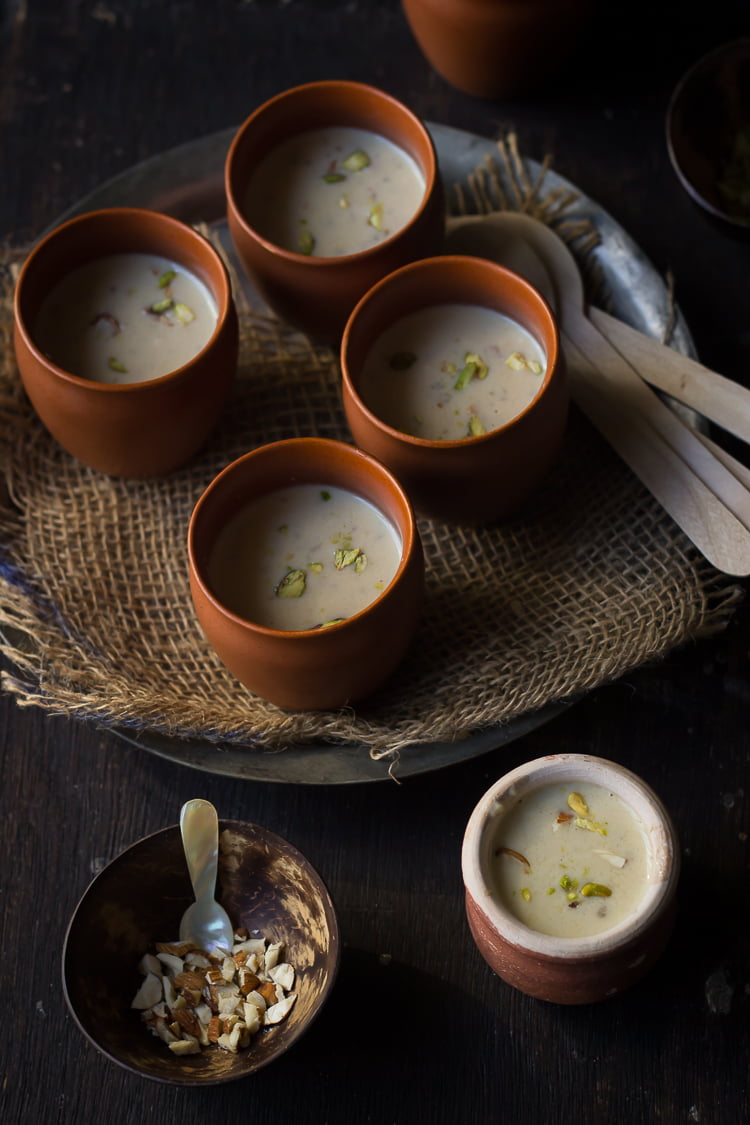Bajre ki Kheer or Pearl Millet Pudding is a traditional way of adding healthy whole grains to our diet to keep us warm in cold months. The cooking process is very simple. We cook parboiled bajra grains with full cream milk on slow flame for rich and delicious kheer. This kheer is not only tasty but also forms an essential part of our diet in chilly weather.
For more kheer recipes you can check out chawal ki kheer, gur ki kheer, and other kheers.

There are so many things, we take for granted. And one of them is food cooked by our mothers. I really wish I could cook many more recipes from my mother’s repertoire. Amen to that!

Only now with more and more emphasis on healthy and clean eating, I have started realising the importance of some recipes which my grandmothers and mother cooked. One of them is using jaggery, grains like bajra and makka. After making gur ki kheer a few weeks back, I made bajre ki kheer for a potluck which we did on the occasion of Makar Sankranti.

I was initially not sure about the reception the pudding would get among my friends but surprisingly, everyone took back helpings home for their family. They also wanted their families to taste and enjoy something different and healthier.
Stirring is important so that kheer doesn’t get stuck to the base of the pan. If the kheer gets stuck to the base of the pan while cooking, first taste the milk for any burnt flavor. If there is no burnt flavor, you can immediately transfer the uncooked kheer to another wok or pan for further cooking and thickening.

De-husking the bajra is also an important step. It sounds confusing but definitely not when you do it. Imagine the same process we do for peanuts, where we roast them and the husk can be easily removed by blowing gently on it. You may be getting de-husked bajra in your grocery shop, so do check it if this doesn’t work for you.
It is done by soaking pearl millet or bajra in a wet cloth for 15-20 minutes. Moisture will loosen the husk of millet, making it easy to remove. Give soaked millet a very quick pulse in a mixer, you don’t want powder, but just enough to separate loosened husk. You can do the same step in a mortar and pestle if you have one instead of a mixer.

There are a few points that we need to keep in mind while making kheer with jaggery – Add jaggery syrup in kheer only when it has completely cooled down, else the milk can coagulate. After adding jaggery syrup, the kheer needs to be consumed chilled and not reheated. Or you can gently warm it by keeping the bowl in a hot water bath (keep the kheer bowl in a bigger bowl of hot water).
I would not recommend replacing jaggery (gur) with sugar as the flavor of this kheer is especially due to the combination of bajra and gur. Sugar will not give the authentic flavor. However, You can also replace jaggery with bura or khand for a rich texture and taste. Try replacing it with the same amount of sugar with khand and adjust if required.
The rich, creamy and delicious bajre ki kheer is perfect for winter and any family get-together that you plan. Cooking in the bajra with milk on slow flame is the true reason for the thick consistency and delectable rich flavor of the kheer. If you try to hasten the process by cooking on full flame, it will compromise on flavor.
Traditional Bajre Ki Kheer Recipe – Best Indian Dessert
Bajre ki Kheer
Ingredients
- 1 litre full cream milk
- ¼ cup pearl millet bajra
- 150 gram jaggery gur, crumbled
- 8-10 almonds badam, slivered
- 8-10 cashew nuts kaju, chopped
- 2 tbsp raisin kismis
- 1 tsp cardamom powder elaichi powder
Instructions
- Soak pearl millet or bajra in a wet cloth for 15-20 minutes. Moisture will loosen the husk of millet, making it easy to remove. Give soaked millet a very quick pulse in the mixer, we don’t want powder, but just enough to separate the loosened husk.
- Remove the pulsed millet into a big platter and blow on them to remove the husk. You may want to be in a area which can be cleaned afterwards or in a garden to absorb all the husk flying. You can do the same step in a mortar and pestle if you have one instead of a mixer. Imagine the same process we do for peanuts, where we roast them and the husk can be easily removed by blowing gently on it.
- Pressure cook the cleaned millet with 1 cup of water for 2-3 whistles. Allow the pressure to release. I usually let it release naturally. Check for doneness by pressing the bajra grains between the thumb and finger. It should press but stay firm. Imagine how dalia (broken wheat) appears after pressure cooking.
- In a thick bottom pan or wok, add boiled millet and milk. Allow it to cook on slow flame, stirring often. Stirring is important so that it doesn’t get stuck to the base of the pan. It will take about 40-45 minutes for bajra to cook as well as milk to reduce.
- In a small pan, add ½ cup water and crumbled jaggery. Allow the jaggery to cook and melt completely. Remove from flame and set aside.
- When bajra is tender and blended well with milk, add cashews, almonds and raisins in it. Mix well. Add cardamom powder and turn off the flame. Allow the kheer to cool completely.
- When the kheer is completely cooled down, strain jaggery syrup and mix well in the kheer. Bajre ki Kheer is ready. Serve chilled and garnish with more chopped almonds and cashews.
Notes
- De-husking the bajra is also an important step. It sounds confusing but definitely not when you do it. Imagine the same process we do for peanuts, where we roast them and the husk can be easily removed by blowing gently on it. You may be getting de-husked bajra in your grocery shop, so do check it if this doesn’t work for you.
- Stirring is important so that kheer doesn’t get stuck to the base of the pan. If the kheer gets stuck to the base of the pan while cooking, first taste the milk for any burnt flavor. If there is no burnt flavor, you can immediately transfer the uncooked kheer in another wok or pan for further cooking and thickening.
- Add jaggery syrup in kheer only when it has completely cooled down, else the milk can coagulate. After adding jaggery syrup, the kheer needs to be consumed chilled and not reheated. Or you can gently warm it by keeping the bowl in a hot water bath (keep the kheer bowl in a bigger bowl of hot water).
- You can use palm or normal jaggery as per your preference.
- You can also replace jaggery with bura or khand for a rich texture and taste. Try replacing it with the same amount of sugar with khand and adjust if required.
- Bajra is a winter special millet, alternatively ragi can be used in summer.
- I would not recommend replacing jaggery (gur) with sugar as the flavor of this kheer is especially due to the combination of bajra and gur. Sugar will not give the authentic flavor.
- Cooking in the bajra with milk on slow flame is the true reason for the thick consistency and delectable rich flavor of the kheer. If you try to hasten the process by cooking on full flame, it will compromise on flavor.

